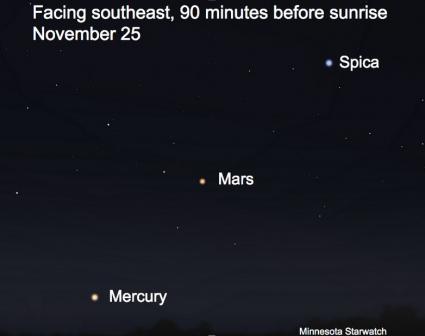Northern Sky: November 23 - December 6
Northern Sky by Deane Morrison
November 23 to December 6, 2019
As we move into the final month of the year, the planets are at play in both the morning and evening skies.
In the predawn hour, Mars and Mercury are both in the east-southeast until the end of November and into December. So is Spica, the brightest star in Virgo, the maiden. These three objects form a diagonal line above the horizon with Spica highest, Mercury lowest, and Mars, of course, in the middle. You might want to look on Sunday, November 24, when a thin crescent moon hovers to the left of Mars. On the 25th, the moon will be thinner and just above the horizon, below Mercury.
As the days go by, Mars’s two companions abandon it. Spica keeps climbing higher, thanks to Earth’s orbital motion. But Earth's motion has a relatively weak influence on Mercury's comings and goings because it's an inner planet and much speedier than Earth. When it pops into the morning sky, it’s coming out from a trip between Earth and the sun. The transit of Mercury across the face of the sun on November 11 was also a transit, officially, out of the evening sky and into the morning. But it soon drops down again, as it starts its next trip around the far side of the sun. So as Spica climbs away and Mercury drops away, Mars gets doubly deserted.
In the evening sky, Jupiter and much brighter Venus pass each other in the southwest on the weekend before Thanksgiving, November 23 and 24. The two planets come as close as 1.5 degrees, or about three moon widths. Try to catch them about 40 minutes after sunset. On Thanksgiving evening, a thin crescent moon of the next cycle will be right above Venus, and Jupiter will be below it to the right. This threesome will be impressive if you can catch it before Jupiter sets. If not, that’s okay; Venus and the moon always make a nice pair.
On Friday, November 29, the moon hangs below and left of Saturn. Saturn hasn’t been especially bright this year, so if you haven’t found it, this moon will guide you. Like Jupiter, Saturn is falling toward the sunset as Earth leaves it behind in the orbital race. The ringed planet also gets a visit from Venus, in the second week of December. It'll be fun to watch these two planets approaching each other.
If you’re out at nightfall, look to the north to see the Big Dipper sitting right above the horizon. When it’s low like this, you can observe the double star at the bend of the dipper’s handle through binoculars without straining your neck too much. Also, find the pointer stars at the far end of the bowl, that is, away from the handle; these point to Polaris, the North Star. Then see if you can spot a lazy triangle of stars to the upper right of the pointer stars; these mark the head, and rather pointed nose, of the Big Dipper’s home constellation: Ursa Major, the great bear.
Bracketing Polaris are two bright stars, both at about the same distance from Polaris. To the left, in the northwest, is Vega, in the Summer Triangle of stars, and to the right, in the northeast, is Capella, in the winter constellation Auriga, the Charioteer. Hanging from Polaris is the Little Dipper. Its midsection is dim, and it’s about all there is to see in the constellation Ursa Minor, the little bear. But since the Latin name Ursa Major is feminine, and Ursa Minor is so close by, Ursa Minor could well be regarded not just as a little bear, but as a bear cub.
Tweet




